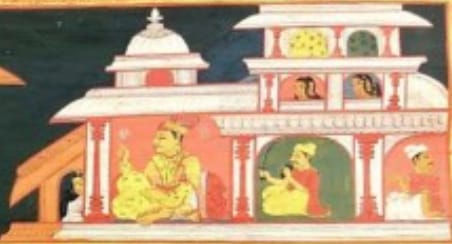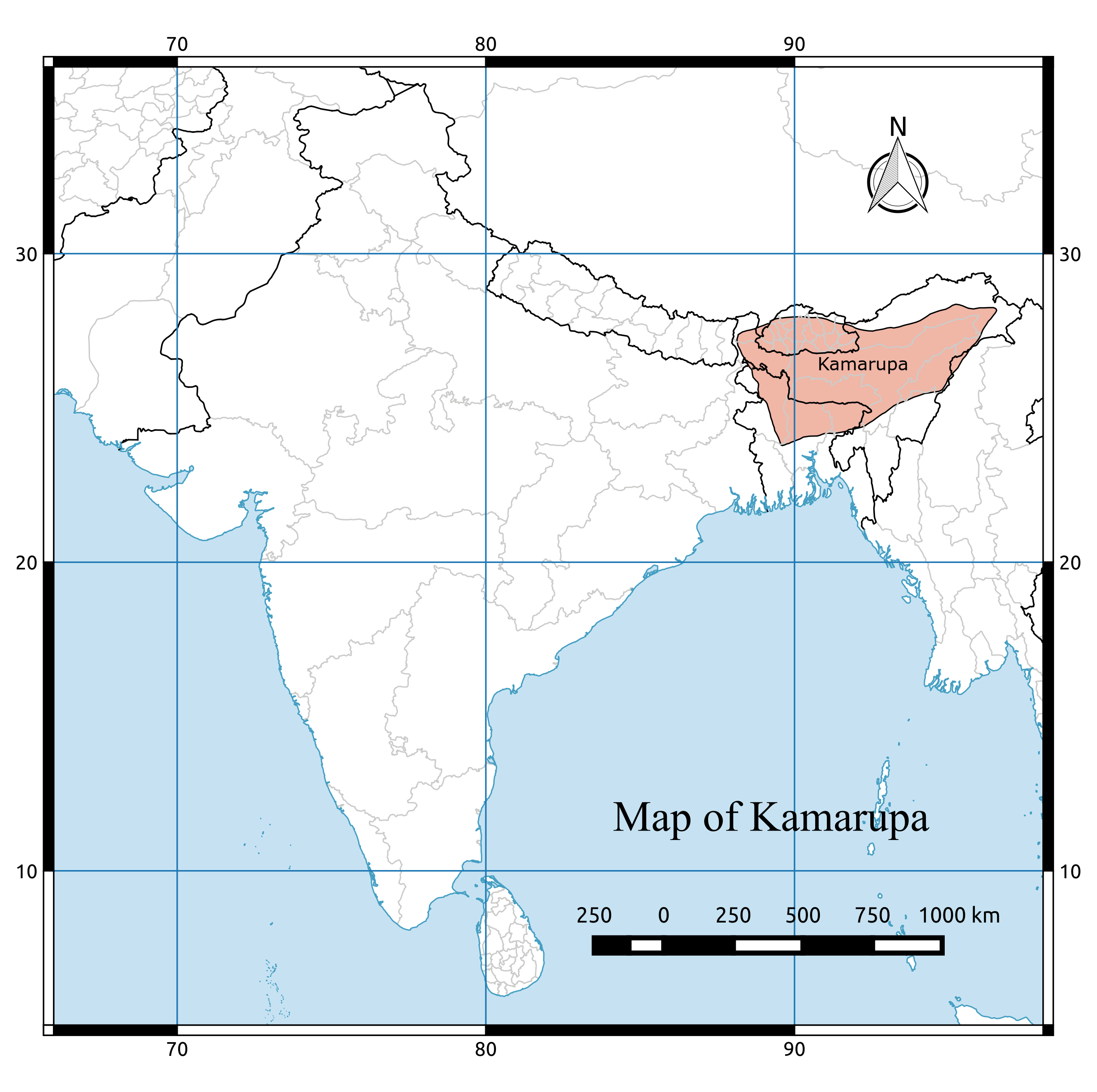|
Phuleshwari
Phuleswari, also known as Pramateswari Devi, was the chief consort of an Ahom king Siva Singha of Ahom kingdom of what is now Assam who ruled the kingdom from 1722 to 1731 A.D. She was the first queen of Ahom kingdom to govern the kingdom directly. She was originally a dancer in a religious temple dedicated to the Hindu God Shiva. When the king saw her, he was captivated by her beauty and decided to marry her and made her his chief consort. Phuleswari after having assumed the title of Bor Raja, coins were minted on her, alongside her husband. Bar raja Birth Phuleshwari earlier known as Phulmati, and was born in the Kalugaon Gayan Gaon in Sivasagar district. Phuleshwari original name was Phulmati. She was born in the Nat caste, a caste of dancers. Reign Captivated by her beauty the king married her and made her the chief consort and name. She was made the Bor Raja by Siva Singha after having declared chatra-bhanga-yoga which means the end of his reign by astrologers, in o ... [...More Info...] [...Related Items...] OR: [Wikipedia] [Google] [Baidu] |
Siva Singha
Sutanphaa also Siva Singha was a king of Assam who reigned from 1714 to 1744 A.D. He was the eldest son of Rudra Singha. Siva Singha was with his dying father at Guwahati, who then proceeded to the capital Rangpur where he ascended to the throne. He is noted is noted for his elaborate system of espionage. He had numerous temples erected and made large gifts of land to them. With his support ''Hinduism became the pre-dominant religion of the Ahoms". The king was also a patron of music and literature and music and himself composed Sanskrit songs and learnt songs. His court poets like Ananta Acharyya composed the Ananda Lahari and Kavichandra, the Kam-Kumar Haran Haran and the Dharma puran at the instance of the king and his first chief queen Phuleshwari. During his reign also came the first Europeans to trade with Assam. Reign As per the wish of Swargadeo Rudra Singha on his deathbed, he was succeeded by his eldest son Siba Singha (reigned 1714–1744). Siba Singha ascended ... [...More Info...] [...Related Items...] OR: [Wikipedia] [Google] [Baidu] |
Sutanphaa
Sutanphaa also Siva Singha was a king of Assam who reigned from 1714 to 1744 A.D. He was the eldest son of Rudra Singha. Siva Singha was with his dying father at Guwahati, who then proceeded to the capital Rangpur where he ascended to the throne. He is noted is noted for his elaborate system of espionage. He had numerous temples erected and made large gifts of land to them. With his support ''Hinduism became the pre-dominant religion of the Ahoms". The king was also a patron of music and literature and music and himself composed Sanskrit songs and learnt songs. His court poets like Ananta Acharyya composed the Ananda Lahari and Kavichandra, the Kam-Kumar Haran Haran and the Dharma puran at the instance of the king and his first chief queen Phuleshwari. During his reign also came the first Europeans to trade with Assam. Reign As per the wish of Swargadeo Rudra Singha on his deathbed, he was succeeded by his eldest son Siba Singha (reigned 1714–1744). Siba Singha ascended ... [...More Info...] [...Related Items...] OR: [Wikipedia] [Google] [Baidu] |
Moamoria Rebellion
The Moamoria rebellion (1769–1805) was the 18th century uprising in Ahom kingdom of present-day Assam that began as power struggle between the Moamorias (''Mataks''), the adherents of the Moamara Sattra, and the Ahom kings. This uprising spread widely to other sections of Ahom kingdom including disgruntled elements of the Ahom aristocracy leading to two periods in which the Ahom king lost control of the capital. Retaking the capital was accompanied by a massacre of subjects, leading to a steep depopulation of large tracts. The Ahom king failed to retake the entire kingdom; a portion in the north-east, Bengmara (modern-day Tinsukia district), became known as '' Matak Rajya'' ruled by a newly created office called ''Borsenapati'', became a tribute-paying but virtually independent territory. The Ahom kingdom emerged from the rebellion much weakened. About one half of the population of the kingdom perished and the economy was totally destroyed. The weakened Ahom kingdom fe ... [...More Info...] [...Related Items...] OR: [Wikipedia] [Google] [Baidu] |
Assam
Assam (; ) is a state in northeastern India, south of the eastern Himalayas along the Brahmaputra and Barak River valleys. Assam covers an area of . The state is bordered by Bhutan and Arunachal Pradesh to the north; Nagaland and Manipur to the east; Meghalaya, Tripura, Mizoram and Bangladesh to the south; and West Bengal to the west via the Siliguri Corridor, a wide strip of land that connects the state to the rest of India. Assamese and Boro are the official languages of Assam, while Bengali is an additional official language in the Barak Valley. Assam is known for Assam tea and Assam silk. The state was the first site for oil drilling in Asia. Assam is home to the one-horned Indian rhinoceros, along with the wild water buffalo, pygmy hog, tiger and various species of Asiatic birds, and provides one of the last wild habitats for the Asian elephant. The Assamese economy is aided by wildlife tourism to Kaziranga National Park and Manas National Park, which are ... [...More Info...] [...Related Items...] OR: [Wikipedia] [Google] [Baidu] |
Shiva
Shiva (; sa, शिव, lit=The Auspicious One, Śiva ), also known as Mahadeva (; ɐɦaːd̪eːʋɐ, or Hara, is one of the principal deities of Hinduism. He is the Supreme Being in Shaivism, one of the major traditions within Hinduism. Shiva is known as "The Destroyer" within the Trimurti, the Hindu trinity which also includes Brahma and Vishnu. In the Shaivite tradition, Shiva is the Supreme Lord who creates, protects and transforms the universe. In the goddess-oriented Shakta tradition, the Supreme Goddess (Devi) is regarded as the energy and creative power (Shakti) and the equal complementary partner of Shiva. Shiva is one of the five equivalent deities in Panchayatana puja of the Smarta tradition of Hinduism. Shiva has many aspects, benevolent as well as fearsome. In benevolent aspects, he is depicted as an omniscient Yogi who lives an ascetic life on Mount Kailash as well as a householder with his wife Parvati and his three children, Ganesha, Kartikeya and ... [...More Info...] [...Related Items...] OR: [Wikipedia] [Google] [Baidu] |
Maidam
A maidam is a tumulus of the royalty and aristocracy of the medieval Ahom Kingdom (1228–1826) in Assam. The royal are found exclusively at Charaideo; whereas other are found scattered in the region between Jorhat and Dibrugarh towns. Structurally, a ''maidam'' consists of vaults with one or more chambers. The vaults have a domical superstructure that is covered by a hemispherical earthen mound that rises high above the ground with an open pavilion at the peak called ''chow chali''. An octagonal dwarf wall encloses the entire ''maidam''. Burial is the predominant funeral rite of the Tai people, to which the Ahom people originally belonged. This is opposed to the Hindu system of cremation. After the Ahom kings adopted Hinduism, they chose to bury the ashes after cremation. The structural construction and the process of royal burials are explained in historical documents called ''Chang-Rung Phukanor Buranji'', which detail even the articles that were buried. Later excavations ... [...More Info...] [...Related Items...] OR: [Wikipedia] [Google] [Baidu] |
Year Of Birth Missing
A year or annus is the orbital period of a planetary body, for example, the Earth, moving in its orbit around the Sun. Due to the Earth's axial tilt, the course of a year sees the passing of the seasons, marked by change in weather, the hours of daylight, and, consequently, vegetation and soil fertility. In temperate and subpolar regions around the planet, four seasons are generally recognized: spring, summer, autumn and winter. In tropical and subtropical regions, several geographical sectors do not present defined seasons; but in the seasonal tropics, the annual wet and dry seasons are recognized and tracked. A calendar year is an approximation of the number of days of the Earth's orbital period, as counted in a given calendar. The Gregorian calendar, or modern calendar, presents its calendar year to be either a common year of 365 days or a leap year of 366 days, as do the Julian calendars. For the Gregorian calendar, the average length of the calendar ... [...More Info...] [...Related Items...] OR: [Wikipedia] [Google] [Baidu] |
1731 Deaths
Events January–March * January 8 – An avalanche from the Skafjell mountain causes a massive wave in the Storfjorden fjord in Norway that sinks all boats that happen to be in the water at the time and kills people on both shores. * January 25 – A fire in Brussels at the Coudenberg Palace, at this time the home of the ruling Austrian Duchess of Brabant, destroys the building, including the state records stored therein."Fires, Great", in ''The Insurance Cyclopeadia: Being an Historical Treasury of Events and Circumstances Connected with the Origin and Progress of Insurance'', Cornelius Walford, ed. (C. and E. Layton, 1876) p49 * February 16 – In China, the Emperor Yongzheng orders grain to be shipped from Hubei and Guangdong to the famine-stricken Shangzhou region of Shaanxi province. * February 20 – Louise Hippolyte becomes only the second woman to serve as Princess of Monaco, the reigning monarch of the tiny European principality, as ... [...More Info...] [...Related Items...] OR: [Wikipedia] [Google] [Baidu] |
History Of India
According to consensus in modern genetics, anatomically modern humans first arrived on the Indian subcontinent from Africa between 73,000 and 55,000 years ago. Quote: "Y-Chromosome and Mt-DNA data support the colonization of South Asia by modern humans originating in Africa. ... Coalescence dates for most non-European populations average to between 73–55 ka." However, the earliest known human remains in South Asia date to 30,000 years ago. Settled life, which involves the transition from foraging to farming and pastoralism, began in South Asia around 7000 BCE. At the site of Mehrgarh presence can be documented of the domestication of wheat and barley, rapidly followed by that of goats, sheep, and cattle. By 4500 BCE, settled life had spread more widely, and began to gradually evolve into the Indus Valley civilisation, an early civilisation of the Old World, which was contemporaneous with Ancient Egypt and Mesopotamia. This civilisation flourished between 2500 BCE and 190 ... [...More Info...] [...Related Items...] OR: [Wikipedia] [Google] [Baidu] |
History Of Assam
File:Major kingdoms of Assam.png, upright=1.3, Major kingdoms of Assam rect 50 50 650 120 Kamarupa Kingdom rect 45 240 160 310 Kamata Kingdom rect 165 240 300 310 Bhuyan chieftains rect 305 240 415 310 Ahom Kingdom rect 425 240 540 310 Chutiya Kingdom rect 550 240 660 310 Kachari Kingdom rect 4 425 80 495 Koch Bihar rect 120 425 190 495 Koch Hajo rect 125 660 640 760 History of Assam The history of Assam is the history of a confluence of people from the east, west, south and the north; the confluence of the Austroasiatic, Tibeto-Burman (Sino-Tibetan), Tai and Indo-Aryan cultures. Although invaded over the centuries, it was never a vassal or a colony to an external power until the third Burmese invasion in 1821, and, subsequently, the British ingress into Assam in 1824 during the First Anglo-Burmese War. The Assamese history has been derived from multiple sources. The Ahom kingdom of medieval Assam maintained chronicles, called Buranjis, written in the Ahom and ... [...More Info...] [...Related Items...] OR: [Wikipedia] [Google] [Baidu] |


.jpg)




.png)
